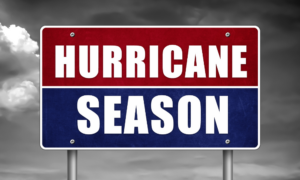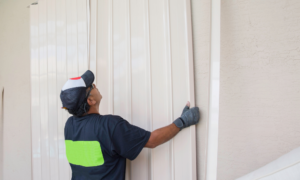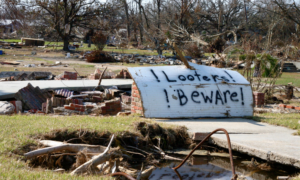Weathering the Storm: Crafting a Hurricane Preparedness Plan for Your Tampa Office Building
Being in the commercial real estate business for over 17+ years, I’ve learned that preparation is key to success, especially in Tampa where a hurricane hit is not a matter of “if” but “when.”

As a commercial real estate broker that specializes in office, the majority of the clients I work with not only want to maximize their income, but they also wish to gain more control over their lives and business, while ensuring consistency in their results, regardless of any obstacles or interruptions they may encounter.
A hurricane, even it is not a direct hit, can cause major interruptions in your income, business, and life. Having a solid hurricane preparedness plan for your office building is one way to mitigate the impact while protecting your investment and income.
Here’s a simple guide to help you get started:
1. Understand the Risks
Knowledge is the first step toward preparation. Understand the risks associated with hurricanes, such as strong winds, heavy rainfall, flooding, and losing power, and how a hurricane may adversely impact your property.
- Is your property located in a flood zone?
- Are you located in an evacuation zone? You can check your property’s zone on the Florida Division of Emergency Management’s Know Your Zone website.
- Are your power lines below or above ground and thus more susceptible to wind and power outages? According to Tampa Electric, about 45% of Tampa’s power lines are underground, mostly in areas of new construction.
- Know what the definition of watches and warnings are and check out the official NOAA site for their timelines.
2. Create a Disaster Response Team
Assign team members specific duties in the event of a hurricane and create a plan that includes:
- Preparation before a storm for your building and tenants.
- Instructions for what activates the preparedness plan.
- A clear map for how the team will communicate with and without electricity and/or cell service.
- Guidelines on access to the building.
3. Secure the Building

The time to secure your building is in the months ahead of hurricane season way before a hurricane watch or warning is issued.
Start securing your building now, leaving only the final touches to be made once a watch is issued so you are not scrambling in the hours ahead of a warning.
- Oil the tracks, hinges, and other hardware of shutters that may have gotten rusty and may be difficult or impossible to close.
- If you don’t have shutters or hurricane-proof windows, consider installing them.
- Make sure you have the corresponding locks, keys, and/or pins for your shutters.
- Put away any outdoor furniture that is not used and secure benches, tables, and other materials that.
- Trim trees now and make sure that any debris is removed as quickly as possible. Lose branches or objects can become deadly projectiles.
- Check your roof for any leaks and be sure to make any repairs as soon as possible.
- Have a plan for securing dumpsters, recycling and garbage bins, and
- Secure outdoor signs if possible
- Ask tenants to disconnect electric cords, devices, and appliances from the main power supply and ensure that all power connections are off.
- Take pictures of your secured building before the storm.
- Even if you are not in a flood zone, protect first-floor doorways and entrances against flood waters. Place sandbags or heavy plastic sheeting with duct tape along each doorway or have flood barriers installed.
- Secure fencing and secure any chemicals you may have in or around your building.
- Check rooftop systems, antennas, equipment, and other structures.
4. Protect Important Documents
When a hurricane is imminent, your focus will likely be on your safety, the safety of your tenants and family, and of course, protecting your property. However, once the storm passes, your recovery will depend on you having your medical, financial, legal, and insurance documents and information readily available.
Make safeguarding your important documents a priority. Start by making digital copies of leases, insurance policies, and critical legal, financial, and tax documents and saving them in a secure cloud.
Store your physical copies in an off-site waterproof and fireproof safe, or in your bank’s safety deposit box.
5. Communicate with Tenants
Communication is vital before, during, and after the hurricane. Keep your tenants informed of the plan and guidelines and remind them of the process at the start of hurricane season. Make sure they know what to do and when they will have access to the building and their office space before and after the weather event.
6. Prepare for Power Outages
If your area has above-ground powerlines, you know that even a regular storm can cause the power to go. If your building doesn’t already have a generator, consider having one installed.
7. Make Sure Your Tenants Have a Business Continuity Plan
It’s in your best interest to make sure that your tenants can get back to work and keep their business going, even after a major weather event. Talk to your tenants and encourage them to create a business continuity plan. Share your experience, knowledge, and informational resources to guide them through the uncertainty a major weather event can cause. After all, your building is a micro-community where your tenants spend the majority of their waking hours. To get started, here is a link to the Ready.gov’s, Ready Business Hurricane Toolkit.
8. Check Your Insurance Coverage
Most standard property insurance policies do not cover hurricanes or flood damage. Check your policy to make sure it is up to date, covers hurricane and flood damage, and /or has the appropriate riders to protect your investment.
9. Post-Hurricane Recovery Plan
After the storm, you’ll want to get back to normal as quickly as possible. The first step in that process begins with the preparation and planning we’ve discussed in this article.
The second step is creating a post-hurricane recovery plan. For your recovery plan you’ll want to consider:
- Assessing the safety of your building and damage to key systems.

- Communicating to your team and tenants on the status of the building, accessibility, and repair timeline.
- Consulting and creating relationships with key contractors, vendors, local officials, and consultants that can aid you in your road back to recovery.
- Taking pictures for your records and to provide your insurance company.
- Securing the site if there is damage to minimize the risk of further weather-related damage or looting.
- How you will assist tenants in case there is severe damage to the building.
10. Regularly Review and Update Your Plan
Make sure your plan remains relevant, practical, and effective by conducting regular reviews and updates, as well as discussing with your team and tenants. Including everyone in the conversation will ensure that you have buy-in from your most important stakeholders.

In the end, being ready for hurricane season isn’t just about protecting your building; it’s also about leaving as little to chance as possible, managing what you have control over, mitigating risk, and making sure that you do what you can to weigh the scales in your favor.
If you’d like assistance in developing a storm plan for your office building in Tampa, reach out. I’m here to help you get the most out of your efforts and do all that we can to secure your property. By sticking together, we can weather any storm or hurricane that comes our way.



